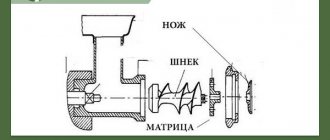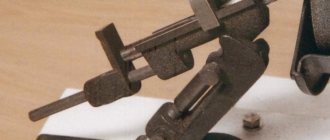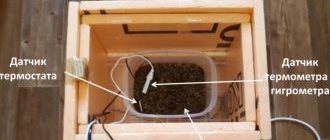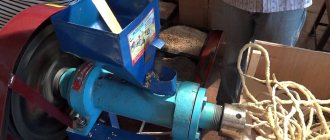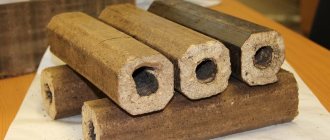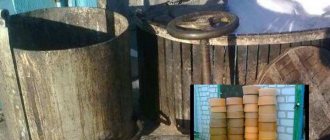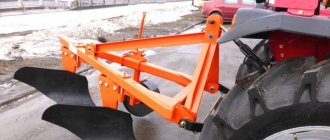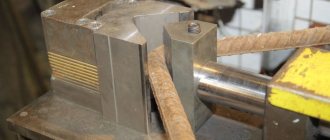Firewood or coal are not available fuels everywhere, but waste from the wood processing industry or agriculture can be found, perhaps, everywhere. It has long been noted that they burn, perhaps a little worse, but they can be used for heating. Just adding sawdust or straw is very inconvenient. Therefore, they came up with the idea of processing them and pressing them into briquettes or pellets. There are even special boilers for fuel granules - pellets. If the fuel is good, they are serviced (the ash is removed) once a month. The best news is that it is quite possible to make pellets with your own hands. This will require quite a lot of equipment, but the basis is a granulator (extruder or pelletizer). There is no way without him.
Do-it-yourself household feed granulator drawings
Do-it-yourself household feed granulator, drawings of equipment with an electric drive, V-belt drive and flat matrix.
Before we begin designing the equipment, we will make a simple calculation.
It should be remembered that:
- The maximum gear ratio of the V-belt drive is no more than 6.
- wrap angle on the small pulley – at least 120°
From the standard range according to GOST 17383-73, we select pulley diameters
Drive pulley (D1), diameter 56 (mm) Driven pulley (D2), diameter 315 (mm)
Calculate the length of the belt
according to the formula: L = 2a + l1 + l2
l – circumference, determined by the formula: l = πDα/360
α1 = 136.57° α2 = 223.43° a = 325.16 (mm)
Let's substitute the values and get:
L = 2 x 325.16 + (3.14 x 56 x 136.57 / 360) + (3.14 x 315 x 223.43 / 360) = 1330.89 (mm)
From the standard range we choose belts Z-1320.
The optimal rotation speed of a flat matrix is 100...150 (rpm). Knowing the gear ratio (D2 / D1 = 315 / 56 = 5.625), we select the AIR 100L8 electric motor.
Let's substitute the values into the formula and get the revolutions of the granulator matrix:
ωр = 750 / 5.625 ≈ 133 (rpm)
Introduction
Recently, home craftsmen have been modernizing and adapting more and more household appliances for the benefit of the household; for example, the engine from a washing machine can be attached to a lathe.
So they didn’t bypass the meat grinder. We decided to make a granulator out of it. I’ll say right away that it won’t be able to granulate anything solid, not under the right loads. Under increased load the rod will break, a household motor may not be able to withstand it, etc...
This granulator is ideal for feed:
- Mix several herbs for rabbits;
- Make some kind of compound feed for other pets.
A household feed granulator consists of the following elements
- V-belt transmission housing (base).
- Granulator matrix drive.
- Granulator rollers.
- Loading hopper.
- Electric motor AIR 100L8.
- Movable plate for mounting the electric motor.
- Belt tension device.
- V-belt transmission.
- Frame.
- Shaft.
- Spatula.
- Matrix.
- Washer.
- Hexagon socket screw DIN 4762 - M8 x 20.
- Spring lock washer DIN 128 - A8.
- Prismatic key DIN 6885 - A8 x 7 x 22.
- Nut DIN 44232 - M8.
- Hexagon socket screw DIN 912 - M8x1 x 30.
- Single row angular contact bearing DIN 625 - 6307 with protective washers or 66307 according to GOST 831-75 (35 x 80 x 21).
- Lock washer DIN 6731 - 32.
- Special nut DIN 1804 – M32x1.5.
- Prismatic key DIN 6885 - A8 x 7 x 50.
In addition, let's watch a two-part video showing the assembly procedure for a household feed granulator with a flat matrix.
Device design
To assemble the mechanism yourself, you need to understand the structure of the granulator. The unit consists of:
- grounds;
- electric motor (power from 15 kW);
- matrices;
- gearbox;
- shaft;
- containers for raw materials and finished products.
The matrix is the main part on which the speed and efficiency of the device depends. It comes in two main types – cylindrical (ring) and flat. The first is a drum with holes and rotating rollers. Under pressure, the raw material passes through the holes and is cut off with special knives at the exit.
What is a granulator
A granulator is a device for converting crumbly feed into capsules.
Suitable for pressing:
- crushed grain (wheat, barley, oats, corn);
- grass meal;
- hay;
- bran;
- cake;
- crushed peas.
The technological properties of the feed are improved, sticking is eliminated, and flowability increases. The digestibility of granules is higher than regular feed. The ability to use vitamin and antimicrobial additives improves the quality of the product.
You may also be interested in information about how much feed a laying hen needs per day.
The video shows how the granulator works:
This food is convenient to use:
- during automatic distribution;
- transportation;
- storage.
The size of the pellets depends on the livestock industry:
- for poultry farming – up to 5 mm;
- for piglets – up to 8 mm;
- adult pigs – up to 10 mm;
- cattle - 10-15 mm.
Build process
To avoid any difficulties during assembly, it is recommended to make drawings first. You can assemble a feed granulator with your own hands using them in a matter of hours. Assembly begins with installing the gearbox into the housing. Its function is to transmit torque from the engine to the shaft. During this process, the roller and die rotate.
A matrix and a roller are mounted in the upper part, which are fixed to the shaft. The rollers themselves are connected by bearings. The bearing is also first placed on the axis of rotation, and then the roller. The structure is pressed to the matrix with a nut. The finished unit is installed in the housing. In this case, the size of the rollers should cover the entire matrix in width.
The engine is installed near the body. The gearbox is connected to it via a belt or chain. A container is mounted on top of the body into which the raw materials will be placed.
Granulator device
The granulator is similar in design to an electric meat grinder with one difference: the knife is located on the outside, behind the matrix grid.
During the granulation process, the raw material mass is loaded into a hopper, from which it is pushed under pressure through a mixture heated to 110 degrees. matrix. The movement of the screw ensures that the mixture is pushed, creating pressure and pressing the crushed and moistened raw materials against the matrix.
Upon reaching a critical volume value, the compressed raw material is forced through the holes of the matrix. A special cutter cuts the granules to the required size. Plastic capsules cool down, maintaining their shape.
You may also be interested in information about how to keep Indian ducks at home.
The operating principle consists of sequential operations:
- supplying crushed feed from the hopper to the rotating shaft;
- compression;
- pressing through the matrix;
- cutting with a knife;
- entering the receiving bowl.
The diameter of the holes in the grid determines the diameter of the capsules. Depending on the power of the electric motor, the diameter can be from 5 to 10-15 mm. The distance at which the knife is installed after the grate determines the length of the granules.
The video shows how the granulator works and works:
Main parts of the granulator:
- loading hopper;
- screw;
- matrix;
- knife;
- drive shaft;
- gearbox;
- electric motor;
- bed;
- receiving bunker.
But how to breed ducks at home for beginners and what you should pay attention to is indicated here.
All parts of the device are made of metal.
The specific characteristics of the thickness and diameter of the matrix, the diameter of the screw, and the power of the electric motor are determined together.
The units offered by manufacturers can be used for preparing not only feed, but also pellets (fuel pellets made from sawdust).
Main characteristics of granulators offered by manufacturers:
- Engine power 2.2 kW. Feed productivity is 60-100 kg/hour. Matrix diameter 120 mm. Weight 80 kg.
- Engine power 4 kW. Feed productivity is 150-220 kg/hour. Matrix diameter 150 mm. Weight 115 kg.
- Engine power 7 kW. Feed productivity 300 kg/hour. Matrix diameter 200 mm. Weight 200 kg.
- Engine power 11 kW. Feed productivity 400 kg/hour. Matrix diameter 230 mm. Weight 290 kg.
- Engine power 15 kW. Feed productivity 600 kg/hour. Matrix diameter 260 mm. Weight 330 kg.
The maximum power of manufactured units is 30 kW with a productivity of more than 1000 kg per hour. The weight of the installation is more than 500 kg.
But what the blue favorite duck looks like and how to properly breed it at home is indicated here.
Device cost
- with a 2.2 kW electric motor – from 53,000 rubles;
- 7 kW – from 83,000 rubles;
- 15 kW – from 190,000 rub.
Advantages of industrial granulators:
- reliability;
- duration of operation;
- versatility;
- efficiency;
- safety;
- convenient service.
The high cost of units manufactured in industrial conditions forces livestock breeders to make devices in a handicraft way, using improvised means.
But you can read here how broilers are raised without feed and what feed should be used.
Operating principle and granule production technology
Pellets are made from various materials - sawdust, wood shavings, bark, peat, wicker and the like. In this case, the raw materials must meet certain requirements:
- contain resins or other adhesives;
- be thoroughly sifted, free from debris and foreign impurities;
- contain 11-13% moisture.
Preparing granules at home requires the use of auxiliary equipment (dryer and grinder) and proceeds as follows:
- The purified fuel is poured into a crusher, where it is crushed.
- The raw materials are poured into a drum dryer (can be made from a metal barrel), bringing it to the desired humidity.
- Re-grinding is carried out.
- The prepared raw materials are poured into a granulator, where it is pressed.
- The resulting pellets are dried, after which they are ready for use.
Making pellets
The advantages of using a granulator are obvious - in its processed form, fuel takes up much less space, and it becomes possible to dispose of waste. In addition, this mechanism can be used to produce feed pellets, which is convenient for farming.
How to make it yourself
To manufacture a granulator on your own, you will need special equipment:
The power of the compactor will depend on the electric motor used.
In the video - do it yourself:
Granulator design option
A pipe and welded bushings of different diameters can be used as a body. The minimum thickness of steel walls is 8 mm. To make an auger, you will need an axle shaft and a rod with a diameter of 1 cm. Having secured the axle shaft on a workbench, weld one end of the rod and make a winding on the axle shaft with an arbitrary pitch. The workpiece must be scalded on both sides, the seams must be cleaned with a grinder and thermally hardened.
Video
If you want to make a granulator from a meat grinder with your own hands, the video in this article will help you determine the correct operation of the device and its appearance, which should be obtained in the end.
We have already written on our website about solid fuel boilers for home heating, how to choose them, and their advantages and disadvantages. Few people know that modern and environmentally friendly solid fuel is not only firewood, but also pellets. For owners who heat their houses with wood, the issue of fuel procurement is always relevant. A modern solution to this problem is the use of compressed granules (pellets) obtained from wood processing products. This fuel has increased efficiency and produces virtually no soot or soot.
Making pellets will help you save money, since wood waste, sawdust and shavings from other industries will be used for production.
Pellets can be ordered from manufacturers. But, if the need for them is constant and significant, and you have access to wood waste or other suitable raw materials (branches, bark, straw), it is more profitable to purchase a granulator for the production of pellets, or make one yourself.
Assembling a granulator at home cannot be called a simple task. But a person who understands the properties of metals, their processing and has design skills is able to cope with it. For those wishing to try to make this useful device on their own, we suggest that you familiarize yourself with the principle of its operation, its varieties and assembly instructions.
Homemade feed granulator drawings
Do-it-yourself household feed granulator, drawings of equipment with an electric drive, V-belt drive and flat matrix.
Before we begin designing the equipment, we will make a simple calculation.
It should be remembered that:
- The maximum gear ratio of the V-belt drive is no more than 6.
- wrap angle on the small pulley – at least 120°
From the standard range according to GOST 17383-73, we select pulley diameters
Drive pulley (D1), diameter 56 (mm) Driven pulley (D2), diameter 315 (mm)
Calculate the length of the belt
according to the formula: L = 2a + l1 + l2
l – circumference, determined by the formula: l = πDα/360
α1 = 136.57° α2 = 223.43° a = 325.16 (mm)
Let's substitute the values and get:
L = 2 x 325.16 + (3.14 x 56 x 136.57 / 360) + (3.14 x 315 x 223.43 / 360) = 1330.89 (mm)
From the standard range we choose belts Z-1320.
The optimal rotation speed of a flat matrix is 100...150 (rpm). Knowing the gear ratio (D2 / D1 = 315 / 56 = 5.625), we select the AIR 100L8 electric motor.
Let's substitute the values into the formula and get the revolutions of the granulator matrix:
ωр = 750 / 5.625 ≈ 133 (rpm)
Additional features
If a large amount of wood waste accumulates on your site, you can also put it to good use using a self-made granulator. Accumulated wood chips must first be dried and then passed through a granulator. As a result, you will receive wood pellets, which can be easily and profitably used during the heating season, of course, if you have stove or steam heating installed in your house.
Pellets
Wood pellets take longer to smolder, and therefore emit a significant amount of heat much longer than chopped firewood. Using this type of fuel will help you save significantly on the purchase of coal and firewood.
Pellet burning
Table. Comparison of heating costs
| Room area, sq. m. | 100 | 150 | 200 | 250 | 300 | 350 | 400 | 500 | 700 | 1000 |
| Pellets, t | 4,9 | 7,4 | 10,3 | 12,3 | 14,7 | 17,2 | 19,6 | 24,5 | 34,3 | 49 |
| Electricity, kWh | 172700 | 25906 | 34542 | 43177 | 51800 | 60449 | 690084 | 86355 | 120800 | 172711 |
| Gas, m3 | 2396 | 3594 | 4792 | 5990 | 7189 | 8387 | 9585 | 11980 | 16774 | 23963 |
| Coal, t | 3,3 | 4,9 | 6,6 | 8,2 | 9,9 | 11,5 | 13,1 | 16,4 | 23 | 32,9 |
| Wood, m cubic. | 13,5 | 20,2 | 27 | 33,7 | 40,4 | 47,2 | 53,9 | 67,4 | 94,4 | 134,8 |
Equipment
There are many options for completing pellet production lines: equipment suppliers offer entrepreneurs a choice of both small stand-alone units with a capacity of 50–150 kg/h, and full-fledged mini-factories that produce tens of tons of wood pellets per shift.
The main element of any complex is the granulator: the market offers models with a diesel engine, an electric drive, or driven by a power take-off shaft. The last option is considered the most economical, but it requires the presence of a tractor itself. In addition, the rest of the production equipment requires connection to electrical networks - accordingly, other things being equal, it is more advisable for a novice entrepreneur to refuse to purchase additional equipment and give preference to the second option.
The list of equipment necessary for the production of pellets is not limited to the production line. The entrepreneur will have to additionally buy a forklift for transporting raw materials, a truck for delivering finished products, and also equip the workstations of the director and accountant with office equipment.
Equipping a workshop with a capacity of 500 kg/h
| Name | price, rub. | Qty | Amount, rub. |
| Workshop (RUB 3,001,000) | |||
| Bunker for raw materials | 15000 | 1 | 15000 |
| Chopper | 140000 | 1 | 140000 |
| Screw conveyor | 58000 | 2 | 116000 |
| Drum dryer | 550000 | 1 | 550000 |
| Hammer mill | 132000 | 1 | 132000 |
| Sawdust hopper | 39000 | 1 | 39000 |
| Mixer | 80000 | 1 | 80000 |
| Granulator | 1212000 | 1 | 1212000 |
| Scraper conveyor | 57000 | 2 | 114000 |
| Cooler | 365000 | 1 | 365000 |
| Pellet hopper | 15000 | 1 | 15000 |
| Weighing system | 98000 | 1 | 98000 |
| Pipelines | – | – | 15000 |
| Lighting | 1000 | 10 | 10000 |
| Installation of equipment | – | – | 100000 |
| Office (RUB 65,800) | |||
| Table | 2500 | 2 | 5000 |
| Armchair | 2000 | 2 | 4000 |
| Chair | 1200 | 4 | 4800 |
| Computer | 18000 | 2 | 36000 |
| Telephone set | 1000 | 2 | 2000 |
| MFP | 9000 | 1 | 9000 |
| Lamp | 1000 | 4 | 4000 |
| Router | 1000 | 1 | 1000 |
| Other equipment (RUB 616,000) | |||
| Forklift | 285000 | 1 | 285000 |
| Hydraulic trolley | 9000 | 1 | 9000 |
| Pallets | 120 | 50 | 6000 |
| Raw material moisture meter | 26000 | 1 | 26000 |
| Freight car | 290000 | 1 | 290000 |
| Total: | 3682800 |
Screw press
Description and benefits
This mechanism is used to produce granulated feed from grain and straw pellets, which are used as top dressing. In just one hour of work, it is possible to process 200 kilograms of raw materials into 200 kilograms of finished feed. You can regulate the amount of product by adjusting the power and performance of the equipment.
The principle of operation is as follows: the raw material is fed into the upper part of the apparatus, which moves inside the wheel, is pressed by a screw through holes in the matrix and takes the form of granules.
Advantages of this type of granulators:
- high performance;
- simplicity of design;
- ease of making with your own hands.
If you improve the device and select more wear-resistant components, you can even recycle wood.
Necessary materials
The materials needed are the same as for the manufacture of a granulator with a flat matrix; the differences appear precisely in the matrix itself.
For production you will need:
- screw DIN 478 M5-10;
- shaft;
- bearing DIN 625-6207;
- bearing cover;
- retaining ring DIN 471-35-1.5;
- sleeve;
- video clip.
Large equipment for manufacturing will require: a welding machine, an angle grinder, a drilling machine and a lathe.
Materials:
- motor;
- gearbox;
- bearings – 2 pcs. to the diameter of the mounting hole;
- metal blank for the matrix;
- metal rod 10 mm;
- pipes for the body.
The structure must be steel, so the components must be reliable, durable, but not harder than steel, so that the screw granulator works for a long time.
Drawing up a drawing
To construct a drawing, the most important parameters are the dimensions of the device itself, the diameter of the screw and the type of matrix: with the size and frequency of the cells.
Everyone chooses the dimensions independently, but the most common are:
- gearbox speed – 120-150 rpm;
- cone angle – 70°;
- case diameter – 58 millimeters;
- screw height – 52 millimeters;
- The diameter of the shaft outlet is 30 millimeters.
Most often, the parameters of parts change as productivity increases: the higher it is, the larger the dimensions required. Ball and tapered roller bearings must be used.
Making a screw
This is the most important step in making a screw granulator with your own hands.
Screw manufacturing steps:
- shaft selection;
- making mounting holes for bearings;
- rolling and welding of rod;
- grinder processing.
The larger the thread pitch, the higher the productivity, and the lower the pressure on the die.
Matrix
There is such a pattern: the larger the matrix cross-section, the higher the efficiency. Small holes need to be widened with a drill and be sure to be sanded. The strength of feed pellets depends on their length, which is determined by the thickness of the matrix disk. In this case, you need to take into account: the longer the granules are planned, the thicker they should be, so you need to increase the diameter of the matrix cells and its thickness.
The matrix is made of steel plate grade 45. It is advisable to use alloy or stainless steel. The thinner the matrix, the faster it wears out. The holes in the cells can be drilled and must be sanded.
The diameter is selected depending on the thickness of the matrix disk: a 6 mm mesh is suitable for a 40 mm disk thickness; 4 mm – for 25 mm; 3 mm - for 20 millimeters, respectively.
The durability of the matrix depends on the following factors:
- consistency of raw materials (presence of abrasive components, lack of oils);
- changing the feed rate of the source material;
- corrosion due to aggressive organic compounds - oils, fats, bran.
The power of the matrix depends on the thickness, so the diameter of the cells should be approximately 8-10 times less than the thickness.
Body of two or three sleeves
To make the casing, you will need a pipe equipped with a replaceable sleeve, which must be welded to the edges of the housing. The loading hole is made from a piece of small diameter pipe. The ends are equipped with flanges.
The bushing can be replaced. Its thickness should be six millimeters. It is necessary to leave a mounting socket to attach the matrix to the inside of the case. Five plates must be welded onto the bushing to distribute the load when feeding raw materials.
How much pellet hay to feed rabbits
Regular feeding of granulated hay helps avoid a common disease in rabbits – hairballs getting stuck in the stomach. The granules help move food through the intestines, and even trapped hairballs do not stay there and are eliminated naturally.
Recommended amount of pelleted feed:
- Not during the mating season, rabbits should be given about 200 grams of granulated food per day in their feeders;
- During pregnancy, a rabbit should eat up to 180 grams of feed and 100 grams of fresh grass;
- a nursing rabbit should be given about 300 grams of granulated hay, gradually increasing the portion to 450 grams;
- during the mating season, before mating, you need to give up to 220 grams of food;
- decorative rabbits should be given up to 150 grams of granules per day;
- monthly rabbits - 110 grams per day.
